#AI with ML & DL Training
Text
AI with ML & DL Training for Shaping Artificial Intelligence
Discover how pursuing training in AI, Machine Learning & Deep Learning can unlock new opportunities & drive innovation at The Data Tech Labs.
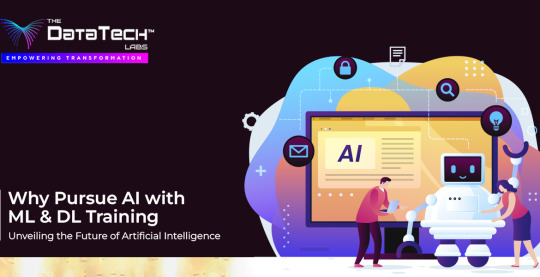
0 notes
Text
Artificial Intelligence & Machine Learning’s Future Contribution
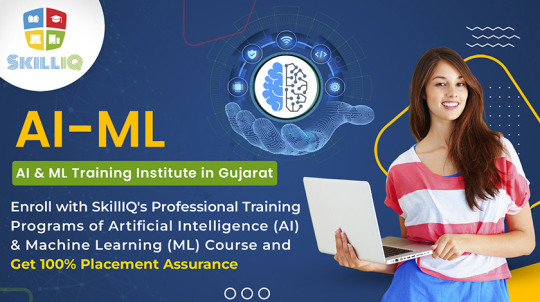
It is sometimes included together with Deep Learning, a recent branch of machine learning research. However, given the cutting-edge research taken on in the field of Deep Learning in particular, it is crucial for all AI enthusiasts to comprehend and stay up to date with the goal of bringing Machine Learning closer to one of its original goals Artificial Intelligence.
The main applications of data in the world we live in today are artificial intelligence and machine learning. Due to this, machine learning is one of the most in-demand fields today, and there is a significant demand for people in the field with the necessary knowledge, training, and practical experience. Great Lakes Post Graduate Program in Machine Learning was created with the express purpose of educating professionals in technologies and techniques used in the real world of business.
What is Artificial Intelligence & Machine Learning?
Artificial Intelligence, which includes replicating cognitive processes like perception, learning, and trouble, is a broad term for systems and algorithms that can emulate human intelligence. Deep learning (DL) and machine learning are branches of AI.
Advanced web search engines, voice-activated personal assistants, self-driving cars, and recommendation systems like those used by Spotify and Netflix are some examples of practical uses of AI.
Artificial Intelligence:
The study of intelligent machines that behave like people is the focus of the computer science field known as artificial intelligence or AI. The process of building intelligent machines, often referred to as smart machines, is intended to help in decision-making, which is carefully examined using data that is readily available within an enterprise. It functions in a similar way to how people do when combining information and coming to logical conclusions. However, in this case, the choice was taken after carefully examining a lot of information.
Machine Learning Work:
A subfield of artificial intelligence known as “machine learning” enables computers to learn and grow without being explicitly programmed. Students who pursue courses in machine learning know how to build automatically adapting computer systems by fusing data mining algorithms models.
Why Study AI & ML?
It will be very helpful to combine artificial intelligence, machine learning, and deep learning since they add a lot of value to the present process and offer intelligent directions for people to follow. The top applications for artificial intelligence & machine learning available that are now in use and have shown to be more effective and accurate for career growth. Choosing AI & ML Training Programs in Gujarat can be more beneficial for anyone’s career development.
Benefits of AI & ML Courses
Along with AI, ML is the gasoline we need to power robots.
We can use ML to power applications that are easily updated and changed to adapt to new surroundings and tasks — getting things done quickly and effectively.
Studying AI And Machine Learning Promises A Bright Career
Learning Helps You Make A Good Living
Artificial Intelligence And Machine Learning Are A Versatile Discipline
Artificial Intelligence And Machine Learning Is The Skill Of The Century
Capable Of Ingesting A Huge Amount Of Data
Helps In Times Of Disasters
Big Bright Career
The Skill of the Century
Artificial Intelligence & Machine Learning’s Future Contribution
The application of machine learning extends beyond the world of investments. Instead, it is growing in all industries, including banking and finance, IT, media & entertainment, gaming, and the auto sector. There are several sectors where academics are trying to revolutionize the world for the future because the reach of machine learning is so broad. Let’s go over them in more depth.
Robotics
One of the disciplines that consistently captures the attention of both researchers and the general public is robotics. George Devol created the first programmable robot in 1954, which he called Unimate. After that, Hanson Robotics produced Sophia, the first AI robot, in the twenty-first century. Artificial Intelligence and Machine Learning made it feasible for these inventions.
The Quantum Computer
The field of machine learning is still in its infancy. There are many improvements that may be made in this area. Quantum computing is one of many that will advance machine learning. It is a sort of computing that makes use of the entanglement and superposition mechanical properties of quantum mechanics. We can construct systems (quantum systems) that can exhibit several states simultaneously by leveraging the quantum phenomena of superposition. Entanglement, on the other hand, is the situation in which two dissimilar states can be referred to one another. It aids in expressing the relationship between a quantum system’s attributes.
Why Enroll with SkillIQ?
Information Technology training has been provided to students, interns, freshers, and those who want to pursue careers in the IT industry by SkillIQ, a professional IT training institute, and incubator. They might hone their IT skills and perform at their peak on the job. We have developed professional training programs for students and interns with the appropriate credentials and real-world experience through internships and online training. The best and most knowledgeable group of mentors from the real world teaches aspirants through professional programs and cutting-edge teaching methods.
Would you be open to enrolling in an AI & ML training program? If so, you’ve come to the correct spot because SkillIQ offers Best AI and ML Training with placement guarantees in Gujarat.
https://www.skilliq.co.in/blog/post-graduate-programme-in-artificial-intelligence-and-machine-learning/
For detailed inquiry Contact us at +91 7600 7800 67 / +91 7777–997–894 Email us at: [email protected]
#artificial intelligence course in ahmedabad#artificial intelligence institute in india#machine learning training#machine learning certification#machine learning courses
2 notes
·
View notes
Text
How can one become a good artificial intelligence engineer?

Becoming a proficient artificial intelligence (AI) engineer requires a combination of education, practical experience, continuous learning, and soft skills development. Here's a comprehensive guide on how to become a good AI engineer and Crypto Price
Understand the Fundamentals: Start by gaining a solid understanding of the fundamental concepts and principles underlying AI, machine learning (ML), and deep learning (DL). Learn about algorithms, data structures, probability, statistics, linear algebra, calculus, and optimization techniques. Online courses, textbooks, and tutorials can help you build a strong foundation in these areas.
Learn Programming Languages: Proficiency in programming languages such as Python, R, and Julia is essential for AI engineering. Python, in particular, is widely used in the AI community due to its simplicity, versatility, and extensive libraries for data manipulation, visualization, and machine learning (e.g., NumPy, pandas, scikit-learn, TensorFlow, PyTorch).
Explore AI Libraries and Frameworks: Familiarize yourself with popular AI libraries and frameworks such as TensorFlow, PyTorch, scikit-learn, Keras, and OpenCV. Experiment with building and training AI models using these tools, and understand their strengths, weaknesses, and best practices for implementation.
Master Machine Learning Techniques: Deepen your understanding of ML algorithms, including supervised learning, unsupervised learning, reinforcement learning, and semi-supervised learning. Study common ML techniques such as linear regression, logistic regression, decision trees, random forests, support vector machines (SVM), k-nearest neighbors (k-NN), clustering, dimensionality reduction, and neural networks.
Explore Deep Learning Architectures: Dive into deep learning architectures and frameworks, including convolutional neural networks (CNNs), recurrent neural networks (RNNs), long short-term memory (LSTM) networks, generative adversarial networks (GANs), and transformer architectures. Understand how these architectures are used in image recognition, natural language processing (NLP), speech recognition, and other AI applications.
Gain Hands-On Experience: Practice building AI models and solving real-world problems through hands-on projects, competitions, and internships. Work on datasets from diverse domains, participate in Kaggle competitions, contribute to open-source projects, and collaborate with peers to gain practical experience and refine your skills.
Stay Updated with Research and Trends: Stay abreast of the latest research papers, publications, and advancements in AI and ML by following conferences (e.g., NeurIPS, ICML, CVPR), journals (e.g., Journal of Machine Learning Research, Nature Machine Intelligence), and online communities (e.g., arXiv, Medium, GitHub). Continuously learning about emerging techniques and trends will help you stay ahead in the field.
Specialize in a Niche Area: Consider specializing in a niche area of AI based on your interests and career goals. This could include computer vision, natural language processing (NLP), speech recognition, robotics, autonomous systems, healthcare AI, financial AI, or AI ethics and governance. Specializing allows you to develop expertise in a specific domain and differentiate yourself in the job market.
Develop Soft Skills: Cultivate soft skills such as critical thinking, problem-solving, communication, teamwork, adaptability, and creativity. AI engineers often collaborate with cross-functional teams, interact with stakeholders, and communicate complex technical concepts to non-technical audiences. Strong soft skills complement technical proficiency and contribute to success in AI engineering roles.
Pursue Continuous Learning: The field of AI is constantly evolving, with new algorithms, techniques, and applications emerging regularly. Embrace a mindset of lifelong learning and commit to continuous improvement by attending workshops, webinars, conferences, and online courses. Stay curious, explore new ideas, and seek opportunities for growth and development in the field.
By following these steps and investing time and effort into learning, practicing, and refining your skills, you can become a proficient AI engineer capable of developing innovative solutions and contributing to the advancement of AI technology. Remember that becoming a good AI engineer is a journey that requires dedication, persistence, and a passion for leveraging AI to solve complex problems and create positive impact in the world and Cryptocurrency Prices and News
Read More Blogs:
How ChatGPT Can Expedite Your Data Science Mastery
Bonk Cryptocurrency is Gaining Traction, But Why?
Best Tech Jobs for MBA Graduates in New Zealand
0 notes
Text
Combine AI Technologies to solve problems.

Building AI applications that combine machine learning (ML), natural language processing (NLP), deep learning (DL), neural networks, and large language models (LLMs) requires a deep understanding of how these components work together.
This integration is crucial for developing AI solutions that can analyze and interpret data, understand human language, and make predictions or decisions based on that data.
How These Components Work Together

ML and NLP: Machine learning algorithms are the backbone of NLP applications. They analyze and interpret text data, enabling applications like chatbots, virtual assistants, and language translation tools. These algorithms can be supervised or unsupervised, learning from labeled or unlabeled data to improve their performance over time.
DL and Neural Networks: Deep learning, a subset of machine learning, utilizes neural networks with multiple layers to learn complex patterns in large datasets. This capability is essential for building advanced NLP models, enabling them to understand and generate human-like text.
LLM and NLP: Large language models, such as GPT-3, are trained on vast amounts of text data. They can generate human-like text and understand the context of the input data, significantly enhancing NLP applications. LLMs are capable of tasks like text generation, summarization, and translation, making them invaluable for NLP applications.
Frameworks and Libraries: Tools like TensorFlow, PyTorch, and Hugging Face provide the necessary functions and structures to implement AI technologies. These frameworks simplify the development and training of models, making it easier for developers to build and deploy AI applications.

Data: The Key to AI Applications
Data is the foundation of AI applications. It is through data that AI models learn to make predictions, understand language, and perform tasks. The quality, quantity, and diversity of the data used to train AI models are crucial factors in their performance and accuracy.
Python Code Snippet to POC These Components Combined

Below is a Python code snippet that demonstrates how to use TensorFlow and Hugging Face's Transformers library to build a simple NLP application. This example uses a pre-trained BERT model for sentiment analysis, showcasing the integration of ML, DL, neural networks, and NLP.
```python
from transformers import pipeline
# Load a pre-trained BERT model for sentiment analysis
sentiment_analysis = pipeline("sentiment-analysis")
# Example text
text = "I love using AI to build applications!"
# Analyze the sentiment of the text
result = sentiment_analysis(text)
# Print the result
print(f"Text: {text}\nSentiment: {result[1]['label']}\nScore: {result[1]['score']}")
```
This code snippet demonstrates how to use a pre-trained model (a neural network) to analyze the sentiment of a piece of text. It showcases the integration of ML (through the use of a pre-trained model), DL (through the use of a neural network), and NLP (through sentiment analysis).

By understanding and integrating these components, developers can build powerful AI solutions that leverage the strengths of ML, NLP, DL, neural networks, and LLMs to analyze and interpret data, understand human language, and make predictions or decisions based on that data.
RDIDINI PROMPT ENGINEER

0 notes
Text
Skillenable Reviews – Career Tracks, Courses, Learning Mode, Fee, Reviews, Ratings and Feedback
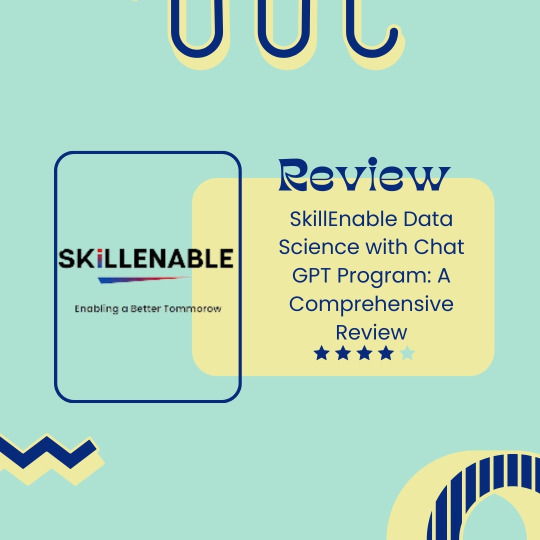
Introduction
SkillEnable's Data Science with Chat GPT Course has gained immense popularity for its comprehensive curriculum and practical approach, earning acclaim in SkillEnable Reviews. In the following sections, we will conduct a detailed analysis of the program, exploring its curriculum, teaching methodology, and outcomes. This examination aims to provide prospective students with valuable insights for informed educational decisions, catering to both seasoned professionals and recent graduates aspiring to thrive in the competitive field of data science.
Understanding SkillEnable Review:
SkillEnable, through skill development and financial support, endeavors to empower the youth in India, making them job-ready. Founded in 2019 by Nirpeksh Kumbhat, SkillEnable bridges the gap between traditional education and industry demands, offering quality education without the burden of high costs. The platform collaborates with educational institutions like IEM BCA, Kolkata, to provide specialized training in data science tools.
Founder and Executive Officer
Nirpeksh Kumbhat, with a background in M.Sc. Finance from The London School of Economics and a B.Sc. Finance degree from the University of Warwick, is the visionary founder of SkillEnable. He envisioned a platform to enable a better tomorrow for Indian youth by providing affordable and skill-focused education.
Partnerships and Collaborations
SkillEnable has partnered with IEM BCA, Kolkata, to educate engineering students about data science tools. This collaboration aims to upskill students in the booming field of data science, aligning educational content with industry requirements. Such initiatives mark a positive shift in the Indian education system, preparing students for practical challenges in their careers.
Key Strategies Implied to Flourish
SkillEnable's success is attributed to key strategies highlighted in SkillEnable Reviews. The platform emphasizes up-skilling through comprehensive training programs, showcasing commitment to empowering professionals. Strategic partnerships, as seen in collaborations with educational institutions, contribute to the platform's success. The SkillEnable initiative stands out for its transformative impact on professional growth.
Exclusive Interview with Nirpeksh Kumbhat, CEO of SkillEnable
An exclusive interview with Nirpeksh Kumbhat sheds light on SkillEnable's mission, vision, and approach to up-skilling. The interview underscores SkillEnable's dedication to delivering high-quality training experiences tailored to evolving learner needs. Through innovative teaching methodologies and strategic partnerships, SkillEnable remains a leader in driving professional development.
Outstanding Placements and Success Stories
SkillEnable's commitment to excellence is evident in its track record of outstanding placements for program graduates. Practical learning, industry-relevant projects, and personalized support contribute to successful career transitions, solidifying SkillEnable's reputation as a leading up-skilling platform.
Detailed Analysis on Accessibility of SkillEnable Website
SkillEnable's website design and navigation are analyzed for user-friendliness. The homepage, category sections, and responsive design ensure a seamless experience. The website incorporates an intuitive menu, robust search functionality, and features promoting accessibility. Course pages are well-structured, simplifying the enrollment process and providing tools for progress tracking.
Courses Offered on SkillEnable
SkillEnable offers a range of courses, including Data Science with Chat GPT, Full Stack Web Development, Front-End Development, Data Analytics with Chat GPT, Business Analytics with Chat GPT, Python, AI, ML, DL with Chat GPT, EV Design & Integration, Advanced Excel with Chat GPT, Power BI with Chat GPT, and Tableau with Chat GPT. Each course is designed to enhance skills in various domains.
SkillEnable Data Science with Chat GPT Program
The Data Science with Chat GPT Program is highlighted, featuring key aspects such as machine learning, deep learning, and data analysis. The program includes a six-month intensive course with career-oriented sessions, resume and LinkedIn profile building, mock interviews, 1:1 career mentoring, placement assistance, and exclusive job access. Eligibility criteria, curriculum, and the program's cost are detailed.
SkillEnable Masters ICT in Data Science: A Preview
SkillEnable's Masters ICT in Data Science program is previewed, emphasizing a comprehensive curriculum covering machine learning, deep learning, and data analysis. The program offers a six-month intensive course with career-oriented sessions, resume assistance, mock interviews, and placement support. The mentorship team, including Nihar Ranjan Roy and Mukesh Poddar, is introduced.
Pros and Cons of SkillEnable
SkillEnable's pros and cons are outlined based on reviews. Pros include a dynamic platform offering a variety of courses, cost EMI options, and collaborative initiatives. Cons involve the absence of FAQs on the website, high-cost courses, and limited information about mentors.
SkillEnable Reviews: Analytics Jobs
Reviews highlight concerns raised by customers, indicating issues related to the details and terms outlined in agreements. Some customers express dissatisfaction, labeling SkillEnable as a deceptive institution.
Conclusion
In conclusion, SkillEnable emerges as a premier platform dedicated to empowering individuals with the skills essential for success in data science. The positive impact reflected in SkillEnable Reviews affirms its effectiveness and reliability. The platform's commitment to excellence, innovative teaching methodologies, and strategic partnerships contribute to its significant influence on the careers of aspiring data scientists worldwide.
SkillEnable's Data Science with Chat GPT Program, with its comprehensive curriculum and career-focused approach, stands as a testament to the platform's commitment to transforming education. Whether for upskilling, career transition, or skill enhancement, SkillEnable remains a trusted partner for success in the dynamic field of data science.
0 notes
Text
How Emerging Technologies like AI, VR, AR, Blockchain, and Quantum Computing Are Changing the World?

Navigating the Frontiers of Innovation: Exploring Emerging Technologies
Introduction of Emerging Technology
In a time of swift tech progress, emerging innovations reshape interactions and industries. AI, VR, AR, blockchain, and quantum computing promise life-changing transformations. Join us on a journey exploring these technologies' intricacies and broad impacts.
1. Artificial Intelligence (AI)
Artificial Intelligence, the "fourth industrial revolution," crafts smart machines mirroring human thought. Machine Learning (ML) and Deep Learning (DL) enable data-driven learning and informed choices. AI excels in healthcare, finance, manufacturing, and entertainment, automating tasks and enriching experiences.
2. Virtual Reality (VR) and Augmented Reality (AR)
Virtual Reality immerses users in simulated environments, while Augmented Reality overlays digital information onto the real world. VR finds its footing in gaming, training, and therapy, offering immersive experiences that transport users to new realms. AR, on the other hand, enhances real-world scenarios, enabling interactive learning, navigation, and entertainment. These technologies shook up entertainment, real estate, and education, altering our perception and interactions with the world.
3. Blockchain
Blockchain, a decentralized and secure digital ledger, is transforming industries like finance, supply chain, and healthcare. By enabling transparent and tamper-proof records, blockchain enhances trust and reduces intermediaries in transactions. Cryptocurrencies, such as Bitcoin and Ethereum, leverage blockchain for secure and borderless financial transactions. Beyond finance, blockchain's potential extends to identity management, voting systems, and ensuring the authenticity of goods.
4. Quantum Computing
Quantum computing is poised to revolutionize computation by leveraging the principles of quantum mechanics. Unlike classical bits, qubits can be in many states at once. Quantum computers solve complex problems lightning-fast. Quantum computing has applications in cryptography, optimization, drug discovery, and climate modeling, potentially solving problems that are currently computationally infeasible.
5. 5G Technology
5G, the fifth wireless generation, offers rapid data speeds, minimal delay, and massive device connectivity. With its capacity to support IoT devices and enable real-time communication, 5G will redefine industries like healthcare, transportation, and manufacturing. Autonomous vehicles, remote surgeries, and smart cities are just a glimpse of the possibilities unlocked by 5G.
6. Biotechnology and Gene Editing
Advances in biotechnology and gene editing, including CRISPR-Cas9, have the potential to revolutionize healthcare and beyond. DNA technologies allow precise DNA changes, from curing genetic diseases to better crops and personalized medicine.

Emerging Technology
Conclusion for Emerging Technology
The emerging technologies of today are the foundation of tomorrow's innovations. AI, VR, AR, blockchain, Quantum computing, 5G, and biotechnology are reshaping industries and pushing the boundaries of what's possible. These technologies have the power to address complex challenges, drive economic growth, and improve the quality of our lives. With each embrace of progress, the future unfolds with endless possibilities, pushing the boundaries of imagination and innovation.
Envisioning Tomorrow: Unveiling Future Technologies and Predictions
Introduction
Technology's swift pace reshapes the world; Quantum computing, AR, and blockchain herald a future once in science fiction. These innovations could revolutionize industries, transform interactions, and set new standards in security and data handling. In this article, we'll delve into these exciting future technologies and explore their implications for the world that lies ahead.
1. Quantum Computing: Computing's Next Frontier
Quantum computing stands at the forefront of the technological revolution, poised to transform the landscape of computation itself. Unlike classical computers that use bits, quantum computers leverage quantum bits or qubits, which can exist in multiple states simultaneously. This enables quantum computers to solve complex problems exponentially faster than their classical counterparts, with applications in cryptography, optimization, drug discovery, and even climate modeling.
As Quantum computing matures, it could revolutionize industries ranging from finance and logistics to scientific research. The ability to process vast amounts of data and simulate complex systems could lead to breakthroughs that were previously unthinkable, unlocking new frontiers in innovation and discovery.
2. Augmented Reality (AR): Bridging Realities
Augmented Reality, which overlays digital information into the real world, is set to bridge the gap between physical and digital experiences. From enhancing navigation and entertainment to transforming education and remote collaboration, AR offers a multitude of possibilities.
In the future, AR could revolutionize industries such as healthcare, where surgeons could have real-time guidance during complex procedures, or architecture, where clients could visualize buildings in real-world settings before construction even begins. The integration of AR with wearable devices and smart glasses could seamlessly blend our digital and physical environments, enriching our daily lives in ways we can't yet fully fathom.
3. Blockchain: Trust in the Digital Age
Blockchain, the technology behind cryptocurrencies like Bitcoin, is poised to disrupt industries by providing secure, transparent, and decentralized record-keeping. Its potential goes far beyond finance, with applications in supply chain management, identity verification, and secure data sharing.
As blockchain evolves, it could lead to a future where data breaches are significantly reduced, and digital transactions are more secure and efficient. Industries that rely on trust and transparency, such as healthcare and legal services, could benefit from blockchain's ability to ensure data integrity and streamline processes.
Future Predictions
- Hyperconnected World: The rise of 5G technology will facilitate unprecedented connectivity, enabling the Internet of Things (IoT) to flourish. From smart cities to autonomous vehicles, our world will become hyperconnected, transforming the way we live, work, and communicate.
- Personalized Medicine: Advances in biotechnology and AI could lead to personalized medicine, tailoring treatments to an individual's genetic makeup and health history.
- Sustainable Technologies: Emerging technologies will play a crucial role in addressing environmental challenges. From renewable energy solutions to efficient resource management, these innovations will shape a more sustainable future.
Conclusion
The future beckons with promises of transformative technologies that have the potential to reshape industries, enhance our daily experiences, and solve some of the world's most pressing challenges. Quantum computing, Augmented Reality, blockchain, and other innovations are not just buzzwords; they represent the evolution of our civilization toward a more connected, secure, and innovative world. As we navigate this exciting journey, embracing these emerging technologies will be key to unlocking the limitless possibilities that lie ahead.
Peering into the Crystal Ball: Future Tech Predictions and Their Societal Impact
Introduction
The rapid march of technology shows no signs of slowing down, and as we stand on the cusp of a new era, exciting innovations are poised to reshape society in ways we can only imagine. From the rise of Artificial Intelligence (AI) and Quantum computing to the convergence of biotechnology and sustainable solutions, the future holds a tapestry of possibilities. In this article, we'll delve into insightful predictions about upcoming technologies and their potential impact on society at large.
1. Artificial Intelligence (AI) Empowering Industries
AI is set to be the cornerstone of future innovation, with Machine Learning and deep learning algorithms becoming more sophisticated and capable. This growth will lead to AI-driven advancements in healthcare, automating diagnostics, and personalized treatment plans. In manufacturing, AI-powered robotics will optimize production lines and supply chains, streamlining efficiency. However, concerns about job displacement and ethical considerations in AI decision-making will need careful attention.
2. Quantum Computing Redefining Possibilities
Quantum computing, with its capacity to perform complex calculations at unparalleled speeds, will revolutionize industries that depend on computational power. From cryptography and drug discovery to climate modeling and optimizing traffic flow, quantum computers will tackle challenges once deemed insurmountable. Yet, the potential for Quantum computing to crack current encryption methods poses cybersecurity challenges that require innovative solutions.
3. Sustainable Tech for a Greener Tomorrow
The imperative to address climate change will drive the adoption of sustainable technologies. Renewable energy sources, like solar and wind, will see remarkable advancements, making clean energy more accessible and affordable. Smart grids will enable efficient energy distribution, while innovative recycling techniques will tackle waste problems. The convergence of IoT and sustainability will lead to smart cities that optimize resource consumption and reduce environmental impact.
4. Biotechnology and Personalized Medicine
Biotechnology will continue to unlock the secrets of genetics, leading to breakthroughs in personalized medicine. Treatments tailored to an individual's genetic makeup will become more commonplace, transforming healthcare from a one-size-fits-all approach to precision medicine. This could lead to better treatment outcomes and improved patient care, although concerns about privacy and data security in genetic information sharing will need to be addressed.
5. Augmented Reality (AR) and Virtual Reality (VR) Transforming Experiences
AR and VR technologies will become integral to various industries, redefining how we experience entertainment, education, and work. AR will enrich our daily lives with real-time information overlays, while VR will transport us to immersive digital realms. The adoption of these technologies will reshape education through interactive learning and redefine how teams collaborate remotely.
6. Ethical Considerations and Regulation
As technology advances, ethical considerations become paramount. Discussions around data privacy, algorithmic bias, and the responsible development and deployment of technologies will intensify. Striking the right balance between innovation and regulation will be crucial to ensure that emerging technologies benefit society as a whole.
Conclusion
The future is an exciting landscape of possibilities driven by emerging technologies. The convergence of AI, Quantum computing, biotechnology, and sustainable solutions will shape society in ways that are both transformative and challenging.
Read the full article
#andQuantumComputingAreChangingtheWorld?#andQuantumComputinginEmergingTechnologies#andtheUgly#AR#ArtificialIntelligence(AI)#Blockchain#EmergingTechnologiesinBusiness:3WaystoStayAheadoftheCurve#EmergingTechnologiesThatWillChangetheWorld#EmergingTechnologiesThatWillTransformYourBusiness#EmergingTechnologies:AGuideforBusinessLeaders#EmergingTechnologies:AGuideforInvestors#EmergingTechnologies:APrimer#EmergingTechnologies:AResourceGuide#EmergingTechnologies:TheEthicalImplications#EmergingTechnologies:TheGood#EmergingTechnologies:TheNextBigThinginBusiness#EmergingTechnologies:WhatYouNeedtoKnow#ExploringtheLatestBreakthroughsinAI#HowEmergingTechnologiesAreChangingtheWorld#HowEmergingTechnologiesAreTransformingOurLives#HowEmergingTechnologieslikeAI#HowtoStayUp-to-DateonEmergingTechnologies#InvestinginEmergingTechnologies:HowtoGetinontheGroundFloor#NavigatingtheFrontiersofInnovation:ExploringEmergingTechnologies#The10MostDisruptiveEmergingTechnologiesof2023#The5EmergingTechnologiesThatWillImpactYourLifetheMost#theBad#TheEthicsofEmergingTechnologies:WhatWeNeedtoConsider#TheFutureofTechnology:5EmergingTechnologiestoWatch#TheFutureofWork:HowEmergingTechnologiesAreChangingJobs
0 notes
Text
Amazon EC2 M7i Instances Hypercharge Cloud AI

Amazon EC2 M7i Instances
Intel would like to demonstrate how the latest Amazon EC2 M7i Instances and M7i-flex instances with 4th Generation Intel Xeon Scalable processors can support your AI, ML, and DL workloads in this second of a three-blog series. They explained these new instances and their broad benefits in the first blog. They wanted to know how AI, ML, and DL workloads perform on these new instances and how Intel CPUs may help.
One research assesses the AI industry at $136.55 billion USD and predicts 37.3% yearly growth until 2030. While you could credit the increase to apparent AI usage like Google and Tesla’s self-driving cars, the advertising and media sector dominates the worldwide AI market. AI and ML/DL workloads are everywhere and growing. Cloud service providers (CSPs) like Amazon Web Services (AWS) are investing in AI/ML/DL services and infrastructure to enable organizations adopt these workloads more readily. Hosting instances with 4th-generation Intel Xeon Scalable CPUs and AI accelerators is one investment.
This article will explain how Intel CPUs and AWS instances are ideal for AI workloads. Two typical ML/DL model types will be used to demonstrate how these instances performed these workloads.
Amazon EC2 M7i &M7i Flex with 4th Gen Intel Xeon Scalables
As mentioned in the previous blog, Amazon EC2 provides M7i and M7i-flex with the newest Intel Xeon CPU. Primary difference: M7i-flex offers changeable performance at a reduced price. This blog will concentrate on regular Amazon EC2 M7i instances for sustained, compute-intensive applications like training or executing machine learning models. M7i instances have 2–192 vCPUs for various requirements. Each instance may accommodate up to 128 EBS disks, providing ample of storage for your dataset. The newest Intel Xeon processors include various built-in accelerators to boost task performance.
For better deep learning performance, all Amazon EC2 M7i instances include Intel Advanced Matrix Extensions (AMX) accelerator. Intel AMX lets customers code AI tasks on the AMX instruction set while keeping non-AI workloads on the CPU ISA. Intel has optimized its oneAPI Deep Neural Network Library (oneDNN) to make AMX easier to use for developers. Open-source AI frameworks like PyTorch, TensorFlow, and ONYX support this API. Intel tested 4th Gen Intel Xeon Scalable processors with AMX capabilities to give 10 times the inference performance of earlier CPUs.
Engineers and developers must adjust their AI, ML, and DL workloads on the newest Amazon EC2 M7i instances with Intel AMX to maximize performance. Intel offers an AI tuning guide to take use of Intel processor benefits across numerous popular models and frameworks. OS-level optimizations, PyTorch, TensorFlow, OpenVINO, and other optimizations are covered throughout the guide. The Intel Model Zoo GitHub site contains pre-trained AI, ML, and DL models pre-validated for Intel hardware, AI workload optimization guidance, best practices, and more.
After learning how Intel and the newest Intel Xeon processors may better AI, ML, and DL workloads, let’s see how these instances perform with object identification and natural language processing.
Models for detecting objects
Object detection models control image-classification applications. This category includes 3D medical scan, self-driving car camera, face recognition, and other models. They will discuss ResNet-50 and RetinaNet.
A 50-layer CNN powers ResNet-50, an image recognition deep learning model. User-trained models identify and categorize picture objects. ResNet-50 models on Intel Model Zoo and others train using ImageNet’s big picture collection. Most object identification models have one or two stages, with two-stage models being more accurate but slower. ResNet-50 and RetinaNet are single-stage models, although RetinaNet’s Focal Loss function improves accuracy without losing speed.
Performance how rapidly these models process photos depends on their use. End consumers don’t want lengthy waits for device recognition and unlocking. Before plant diseases and insect incursions damage crops, farmers must discover them immediately. Intel’s MLPerf RetinaNet model demonstrates that Amazon EC2 M7i instances analyze 4.11 times more samples per second than M6i instances.
As CPUs rise, ResNet-50 performance scales nicely, so you can retain high performance independent of dataset and instance size. An Amazon EC2 M7i instance with 192 vCPUs has eight times the ResNet-50 throughput of a 16vCPU instance. Higher-performing instances provide better value. Amazon EC2 M7i instances analyzed 4.49 times more samples per dollar than M6i instances in RetinaNet testing. These findings demonstrate that Amazon EC2 M7i instances with 4th Gen Intel Xeon Scalable CPUs are ideal for object identification deep learning tasks.
Natural Language Models
You’re probably using natural language processing engines when you ask a search engine or chatbot a query. NLP models learn real speech patterns to comprehend and interact with language. BERT machine learning models can interpret and contextualize text in addition to storing and presenting it. Word processing and phone messaging applications now forecast content based on what users have typed. Small firms benefit from chat boxes for first consumer contacts, even if they don’t run Google Search. These firms require a clear, fast, accurate chatbot.
Chatbots and other NLP model applications demand real-time execution, therefore speed is crucial. With Amazon EC2 M7i instances and 4th Generation Intel Xeon processors, NLP models like BERT and RoBERTa, an optimized BERT, perform better. One benchmark test found that Amazon EC2 M7i instances running RoBERTa analyzed 10.65 times more phrases per second than Graviton-based M7g instances with the same vCPU count. BERT testing with the MLPerf suite showed that throughput scaled well when they raised the vCPU count of Amazon EC2 M7i instances, with the 192-vCPU instance attaining almost 4 times the throughput of the 32-vCPU instance.
The Intel AMX accelerator in the 4th Gen Intel Xeon Scalable CPUs helps the Amazon EC2 M7i instances function well. Intel gives clients everything they need to improve NLP workloads with publicly accessible pre-optimized Intel processor models and tuning instructions for particular models like BERT. Amazon EC2 M7i instances outperformed M7g instances by 8.62 times per dollar, as RetinaNet showed.
Conclusion
For AI, ML, and DL, cloud decision-makers should use Amazon EC2 M7i instances with 4th Generation Intel Xeon Scalable CPUs. These instances include Intel AMX acceleration, tuning guidelines, and optimized models for many typical ML applications, delivering up to 10 times the throughput of Graviton-based M7g instances. Watch for further articles on how the newest Amazon EC2 M7i and M7i-flex instances may serve different workloads.
Read more on Govindhtech.com
1 note
·
View note
Text
Understanding the Differences: Machine Learning vs Deep Learning vs Artificial Intelligence
In today's tech-driven world, terms like Machine Learning (ML), Deep Learning (DL), and Artificial Intelligence (AI) are often used interchangeably, leading to confusion about their actual meanings and applications. It's important to understand the distinctions between these concepts and their latest trends to harness their potential effectively.
Machine Learning (ML):
- ML is a subset of AI that focuses on developing algorithms and statistical models to enable computers to improve their performance on a specific task over time.
- It involves the use of training data to build a model that can make predictions or decisions without being explicitly programmed.
- ML technologies and trends:
- Supervised learning for classification and regression tasks.
- Unsupervised learning for clustering and association tasks.
- Reinforcement learning for decision-making and control problems.
- Transfer learning for leveraging pre-trained models for new tasks.
- AutoML for automating the process of building machine learning models.
Deep Learning (DL):
- DL is a subset of ML that uses artificial neural networks with multiple layers (deep neural networks) to learn from data.
- It aims to mimic the human brain's ability to process data and create patterns for decision-making.
- DL technologies and trends:
- Convolutional Neural Networks (CNN) for image and video recognition.
- Recurrent Neural Networks (RNN) for sequential data processing.
- Generative Adversarial Networks (GAN) for generating new data samples.
- Transformers for natural language processing and language translation.
- Federated Learning for training models on decentralized data.
Artificial Intelligence (AI):
- AI is the broader concept of machines or systems that can perform tasks requiring human intelligence, such as visual perception, speech recognition, decision-making, and language translation.
- It encompasses both ML and DL techniques to achieve cognitive abilities.
- AI technologies and trends:
- Explainable AI for transparent and interpretable machine learning models.
- Edge AI for running AI algorithms on edge devices like smartphones and IoT devices.
- AI ethics and bias mitigation for responsible AI deployment.
- AI-powered automation for streamlining business processes.
- AI in healthcare for diagnosis, treatment planning, and personalized medicine.
Latest Trends:
- Integration of ML, DL, and AI in various domains such as finance, healthcare, retail, and manufacturing for process optimization and predictive analytics.
- Advancements in natural language processing with AI-powered chatbots, language translation, and sentiment analysis.
- Rise of AI-driven personalized recommendations in e-commerce, entertainment, and content delivery platforms.
- Increased adoption of DL techniques in computer vision applications for object detection, image segmentation, and autonomous vehicles.
- Emphasis on ethical AI practices, data privacy, and regulatory compliance in AI development and deployment.
At Mansa Infotech, we specialize in providing cutting-edge solutions in Machine Learning, Deep Learning, and Artificial Intelligence. Ecommerce Development Near Me Our team of experts is dedicated to leveraging the latest technologies and trends to deliver tailored AI solutions for businesses across diverse industries. Please feel free to contact us for any inquiries or collaborations.
1 note
·
View note
Text
Carl Froggett, CIO of Deep Instinct – Interview Series
New Post has been published on https://thedigitalinsider.com/carl-froggett-cio-of-deep-instinct-interview-series/
Carl Froggett, CIO of Deep Instinct – Interview Series


Carl Froggett, is the Chief Information Officer (CIO) of Deep Instinct, an enterprise founded on a simple premise: that deep learning, an advanced subset of AI, could be applied to cybersecurity to prevent more threats, faster.
Mr. Froggett has a proven track record in building teams, systems architecture, large scale enterprise software implementation, as well as aligning processes and tools with business requirements. Froggett was formerly Head of Global Infrastructure Defense, CISO Cyber Security Services at Citi.
Your background is in the finance industry, could you share your story of how you then transitioned to cybersecurity?
I started working in cybersecurity in the late 90s when I was at Citi, transitioning from an IT role. I quickly moved into a leadership position, applying my experience in IT operations to the evolving and challenging world of cybersecurity. Working in cybersecurity, I had the opportunity to focus on innovation, while also deploying and running technology and cybersecurity solutions for various business needs. During my time at Citi, my responsibilities included innovation, engineering, delivery, and operations of global platforms for Citi’s businesses and customers globally.
You were part of Citi for over 25 years and spent much of this time leading teams responsible for security strategies and engineering aspects. What was it that enticed you to join the Deep Instinct startup?
I joined Deep Instinct because I wanted to take on a new challenge and use my experience in a different way. For 15+ years I was heavily involved in cyber startups and FinTech companies, mentoring and growing teams to support business growth, taking some companies through to IPO. I was familiar with Deep Instinct and saw their unique, disruptive deep learning (DL) technology produce results that no other vendor could. I wanted to be part of something that would usher in a new era of protecting companies against the malicious threats we face every day.
Can you discuss why Deep Instinct’s application of deep learning to cybersecurity is such a game changer?
When Deep Instinct initially formed, the company set an ambitious goal to revolutionize the cybersecurity industry, introducing a prevention-first philosophy rather than being on the back foot with a “detect, respond, contain” approach. With increasing cyberattacks, like ransomware, zero-day exploitations, and other never-before-seen threats, the status quo reactionary security model is not working. Now, as we continue to see threats rise in volume and velocity because of Generative AI, and as attackers reinvent, innovate, and evade existing controls, organizations need a predictive, preventative capability to stay one step ahead of bad actors.
Adversarial AI is on the rise with bad actors leveraging WormGPT, FraudGPT, mutating malware, and more. We’ve entered a pivotal time, one that requires organizations to fight AI with AI. But not all AI is created equal. Defending against adversarial AI requires solutions that are powered by a more sophisticated form of AI, namely, deep learning (DL). Most cybersecurity tools leverage machine learning (ML) models that present several shortcomings to security teams when it comes to preventing threats. For example, these offerings are trained on limited subsets of available data (typically 2-5%), offer just 50-70% accuracy with unknown threats, and introduce many false positives. ML solutions also require heavy human intervention and are trained on small data sets, exposing them to human bias and error. They’re slow, and unresponsive even on the end point, letting threats linger until they execute, rather than dealing with them while dormant. What makes DL effective is its ability to self-learn as it ingests data and works autonomously to identify, detect, and prevent complicated threats.
DL allows leaders to shift from a traditional “assume breach” mentality to a predictive prevention approach to combat AI-generated malware effectively. This approach helps identify and mitigate threats before they happen. It delivers an extremely high efficacy rate against known and unknown malware, and extremely low false-positive rates versus ML-based solutions. The DL core only requires an update once or twice a year to maintain that efficacy and, as it operates independently, it does not require constant cloud lookups or intel sharing. This makes it extremely fast and privacy-friendly.
How is deep learning able to predictively prevent unknown malware that has never previously been encountered?
Unknown malware is created in a few ways. One common method is changing the hash in the file, which could be as small as appending a byte. Endpoint security solutions that rely on hash blacklisting are vulnerable to such “mutations” because their existing hashing signatures will not match those new mutations’ hashes. Packing is another technique in which binary files are packed with a packer that provides a generic layer on the original file — think of it as a mask. New variants are also created by modifying the original malware binary itself. This is done on the features that security vendors might sign, starting from hardcoded strings, IP/domain names of C&C servers, registry keys, file paths, metadata, or even mutexes, certificates, offsets, as well as file extensions that are correlated to the encrypted files by ransomware. The code or parts of code can also be changed or added, which evade traditional detection techniques.
DL is built on a neural network and uses its “brain” to continuously train itself on raw data. An important point here is DL training consumes all the available data, with no human intervention in the training — a key reason why it’s so accurate. This leads to a very high efficacy rate and a very low false positive rate, making it hyper resilient to unknown threats. With our DL framework, we do not rely on signatures or patterns, so our platform is immune to hash modifications. We also successfully classify packed files — whether using simple and known ones, or even FUDs.
During the training phase, we add “noise,” which changes the raw data from the files we feed into our algorithm, in order to automatically generate slight “mutations,” which are fed in each training cycle during our training phase. This approach makes our platform resistant to modifications that are applied to the different unknown malware variants, such as strings or even polymorphism.
A prevention-first mindset is often key to cybersecurity, how does Deep Instinct focus on preventing cyberattacks?
Data is the lifeblood of every organization and protecting it should be paramount. All it takes is one malicious file to get breached. For years, “assume breach” has been the de facto security mindset, accepting the inevitability that data will be accessed by threat actors. However, this mindset, and the tools based on this mentality, have failed to provide adequate data security, and attackers are taking full advantage of this passive approach. Our recent research found there were more ransomware incidents in the first half of 2023 than all of 2022. Effectively addressing this shifting threat landscape doesn’t just require a move away from the “assume breach” mindset: it means companies need an entirely new approach and arsenal of preventative measures. The threat is new and unknown, and it is fast, which is why we see these results in ransomware incidents. Just like signatures couldn’t keep up with the changing threat landscape, neither can any existing solution based on ML.
At Deep Instinct, we’re leveraging the power of DL to provide a prevention-first approach to data security. The Deep Instinct Predictive Prevention Platform is the first and only solution based on our unique DL framework specifically designed for cybersecurity. It is the most efficient, effective, and trusted cybersecurity solution on the market, preventing >99% of zero-day, ransomware, and other unknown threats in <20 milliseconds with the industry’s lowest (<0.1%) false positive rate. We’ve already applied our unique DL framework to securing applications and endpoints, and most recently extended the capabilities to storage protection with the launch of Deep Instinct Prevention for Storage.
A shift toward predictive prevention for data security is required to stay ahead of vulnerabilities, limit false positives, and alleviate security team stress. We’re at the forefront of this mission and it’s starting to gain traction as more legacy vendors are now touting prevention-first capabilities.
Can you discuss what type of training data is used to train your models?
Like other AI and ML models, our model trains on data. What makes our model unique is it does not need data or files from customers to learn and grow. This unique privacy aspect gives our customers an added sense of security when they deploy our solutions. We subscribe to more than 50 feeds which we download files from to train our model. From there, we validate and classify data ourselves with algorithms we developed internally.
Because of this training model, we only have to create 2-3 new “brains” a year on average. These new brains are pushed out independently, significantly reducing any operational impact to our customers. It also does not require constant updates to keep pace with the evolving threat landscape. This is the advantage of the platform being powered by DL and enables us to provide a proactive, prevention-first approach whereas other solutions that leverage AI and ML provide reactionary capabilities.
Once the repository is ready, we build datasets using all file types with malicious and benign classifications along with other metadata. From there, we further train a brain on all available data – we don’t discard any data during the training process, which contributes to low false positives and a high efficacy rate. This data is continually learning on its own without our input. We tweak outcomes to teach the brain and then it continues to learn. It’s very similar to how a human brain works and how we learn – the more we are taught, the more accurate and smarter we become. However, we are extremely careful to avoid overfitting, to keep our DL brain from memorizing the data rather than learning and understanding it.
Once we have an extremely high efficacy level, we create an inference model that is deployed to customers. When the model is deployed in this stage, it cannot learn new things. However, it does have the ability to interact with new data and unknown threats and determine whether they are malicious in nature. Essentially it makes a “zero day” decision on everything it sees.
Deep Instinct runs in a client’s container environment, why is this important?
One of our platform solutions, Deep Instinct Prevention for Applications (DPA), offers the ability to leverage our DL capabilities through an API / iCAP interface. This flexibility enables organizations to embed our revolutionary capabilities within applications and infrastructure, meaning we can expand our reach to prevent threats using a defense-in-depth cyber strategy. This is a unique differentiator. DPA runs in a container (which we provide), and aligns with the modern digitization strategies our customers are implementing, such as migrating to on-premises or cloud container environments for their applications and services. Generally, these customers are also adopting a “shift left” with DevOps. Our API-oriented service model complements this by enabling Agile development and services to prevent threats.
With this approach Deep Instinct seamlessly integrates into an organization’s technology strategy, leveraging existing services with no new hardware or logistics concerns and no new operational overhead, which leads to a very low TCO. We utilize all of the benefits that containers offer, including massive auto-scaling on demand, resiliency, low latency, and easy upgrades. This enables a prevention-first cybersecurity strategy, embedding threat prevention into applications and infrastructure at massive scale, with efficiencies that legacy solutions cannot achieve. Due to DL characteristics, we have the advantage of low latency, high efficacy / low false positive rates, combined with being privacy sensitive – no file or data ever leaves the container, which is always under the customer’s control. Our product does not need to share with the cloud, do analytics, or share the files/data, which makes it unique compared to any existing product.
Generative AI offers the potential to scale cyber-attacks, how does Deep Instinct maintain the speed that is needed to deflect these attacks?
Our DL framework is built on neural networks, so its “brain” continues to learn and train itself on raw data. The speed and accuracy at which our framework operates is the result of the brain being trained on hundreds of millions of samples. As these training data sets grow, the neural network continuously gets smarter, allowing it to be much more granular in understanding what makes for a malicious file. Because it can recognize the building blocks of malicious files at a more detailed level than any other solution, DL stops known, unknown, and zero-day threats with better accuracy and speed than other established cybersecurity products. This, combined with the fact our “brain” does not require any cloud-based analytics or lookups, makes it unique. ML on its own was never good enough, which is why we have cloud analytics to underpin the ML –- but this makes it slow and reactive. DL simply does not have this constraint.
What are some of the biggest threats that are amplified with Generative AI that enterprises should take note of?
Phishing emails have become much more sophisticated thanks to the evolution of AI. Previously, phishing emails were typically easy to spot as they were usually laced with grammatical errors. But now threat actors are using tools like ChatGPT to craft more in-depth, grammatically correct emails in a variety of languages that are harder for spam filters and readers to catch.
Another example is deep fakes which have become much more realistic and believable due to the sophistication of AI. Audio AI tools are also being used to simulate executives’ voices within a company, leaving fraudulent voicemails for employees.
As noted above, attackers are using AI to create unknown malware that can modify its behavior to bypass security solutions, evade detection, and spread more effectively. Attackers will continue to leverage AI not just to build new, sophisticated, unique and previously unknown malware which will bypass existing solutions, but also to automate the “end to end” attack chain. Doing this will significantly reduce their costs, increase their scale, and, at the same time, result in attacks having more sophisticated and successful campaigns. The cyber industry needs to re-think existing solutions, training, and awareness programs that we’ve relied on for the last 15 years. As we can see in the breaches this year alone, they’re already failing, and it is going to get worse.
Could you briefly summarize the types of solutions that are offered by Deep Instinct when it comes to application, endpoint, and storage solutions?
The Deep Instinct Predictive Prevention Platform is the first and only solution based on a unique DL framework specifically designed to solve today’s cybersecurity challenges — namely, preventing threats before they can execute and land on your environment. The platform has three pillars:
Agentless, in a containerized environment, connected via API or ICAP: Deep Instinct Prevention for Applications is an agentless solution that prevents ransomware, zero-day threats, and other unknown malware before they reach your applications, without impacting user experience.
Agent-based on the endpoint: Deep Instinct Prevention for Endpoints is a standalone pre-execution prevention first platform — not on-execution like most solutions today. Or it can provide an actual threat prevention layer to complement any existing EDR solutions. It prevents known and unknown, zero-day, and ransomware threats pre-execution, before any malicious activity, significantly reducing the volume of alerts and reducing false positives so that SOC teams can exclusively focus on high-fidelity, legitimate threats.
A prevention-first approach to storage protection: Deep Instinct Prevention for Storage offers a predictive prevention approach to stopping ransomware, zero-day threats, and other unknown malware from infiltrating storage environments — whether data is stored on-prem or in the cloud. Providing a fast, extremely high efficacy solution on the centralized storage for the customers prevents the storage from becoming a propagation and distribution point for any threats.
Thank you for the great review, readers who wish to learn more should visit Deep Instinct.
#2022#2023#agile#Agile Development#ai#algorithm#Algorithms#amp#Analytics#API#applications#approach#architecture#attackers#audio#awareness#background#Behavior#Bias#binary#Brain#brains#breach#Building#Business#Byte#certificates#challenge#chatGPT#chief information officer
1 note
·
View note
Text
Machine Learning vs. Deep Learning: Understanding the Differences
In the realm of artificial intelligence (AI) and data science, two terms that often pop up are "Machine Learning" and "Deep Learning." While they might sound similar, they represent distinct approaches to solving problems. Understanding the differences between these two is crucial for anyone diving into the fascinating world of AI and data-driven solutions. In this article, we'll explore the contrasts between Machine Learning and Deep Learning.
Machine Learning: The Foundation
Machine Learning (ML) is the elder sibling, the foundational concept that laid the groundwork for AI's resurgence. At its core, ML is about training algorithms to learn from data and make predictions or decisions without being explicitly programmed. Think of it as a versatile toolbox with various techniques like linear regression, decision trees, and support vector machines.
ML algorithms excel in supervised, unsupervised, and reinforcement learning tasks. For instance, they can classify spam emails, recommend movies, cluster customer preferences, or optimize supply chain logistics. ML models rely on features—engineered representations of data—making them interpretable, which is beneficial for understanding how decisions are made.
Deep Learning: The Rising Star
Deep Learning (DL), on the other hand, is a subset of Machine Learning and represents a more recent breakthrough. It revolves around artificial neural networks, which are inspired by the human brain's structure. These neural networks consist of layers of interconnected nodes (neurons) that transform and process data.
What sets DL apart is its ability to automatically learn intricate patterns and representations from raw data. This makes it exceptionally powerful for tasks like image recognition, natural language processing (NLP), and speech recognition. Deep Learning models, particularly Convolutional Neural Networks (CNNs) and Recurrent Neural Networks (RNNs), have achieved remarkable success in these domains.
Key Differences
Data Complexity: ML is suitable for structured data with engineered features, while DL can handle unstructured data, such as images, audio, and text, with minimal feature engineering.
Feature Engineering: ML often requires significant manual feature engineering, whereas DL automatically learns features from the data.
Model Complexity: DL models are more complex due to their deep neural networks with many layers, while ML models are usually simpler.
Hardware Requirements: DL typically demands more computational power and specialized hardware, like Graphics Processing Units (GPUs), compared to ML.
Interpretability: ML models are generally more interpretable because they rely on human-engineered features, while DL models are often considered black boxes.
Performance: DL shines in tasks with large datasets and complex patterns, but it may overfit with limited data. ML models are more suitable for small to medium-sized datasets.
Conclusion
In the Machine Learning vs. Deep Learning debate, there is no one-size-fits-all answer. The choice between them depends on the specific problem you're tackling and the resources at your disposal. Machine Learning is versatile, interpretable, and often sufficient for many applications. Deep Learning, with its ability to automatically extract intricate features from unstructured data, excels in complex tasks but comes at the cost of increased computational requirements and lower interpretability.
Ultimately, both approaches have their strengths and places in the field of AI and data science. Understanding these differences empowers data scientists and engineers to choose the right tool for the job, ensuring the best possible results in their AI-driven endeavors.
About the Author
Meet Manisha, a Senior Research Analyst at Digicrome with a passion for exploring the world of Data Analytics, Artificial intelligence, Machine Learning, and Deep Learning. With her insatiable curiosity and desire to learn, Manisha is constantly seeking opportunities to enhance her knowledge and skills in the field.
For Data Science course & certification related queries visit our website:- www.digicrome.com & you can also call our Support:- 0120 311 3765
#artificial intelligence#programming#data scientist#machine learning#data science#my writing#mobile app development#software development#web development#digicrome
0 notes
Text
Artificial Intelligence in Cancer Diagnosis
Over the past several decades, pathologists and clinicians have evaluated tumors using several data modalities such as Radiology/Imaging, Pathology, Genomics and Drug Discovery. These have been correlated with each other either manually or using sophisticated statistical approaches. Artificially Intelligent (AI) models trained on radiographic or histopathology-based images have been known to predict status of tumors (i.e., whether it’s benign or cancerous). AI models have also been trained on radiographic image features to predict gene expressions in cancer. Further, all the aforementioned modalities (or features from them) could be stitched together into an AI model to predict patient outcomes in cancer.
The screening of cancer patients in the clinic encompasses various data modalities, including imaging using radiological techniques that include computed tomography (CT), magnetic resonance imaging (MRI) and positron emission tomography followed by a surgical biopsy of the tumor region of interest (ROI) as segmented by radiologists on these images using software such as 3dSlicer, ITK-SNAP and Myrian Studio. The biopsied tumor material, also termed as “specimen” is examined by a pathologist for its shape, size and other physical features. The specimen is then cut into thin slices, i.e., “histological sections” that are fixed on a glass slide using paraffin-formalin, followed by their staining using hematoxylin that aids visualization of several components of the underlying cells, such as cell nuclei and ribosomes, under a microscope. This setup allows pathologists to analyze and mark several cellular or protein markers present in the specimen. Further, these slides are sent to a genomics laboratory to scrape off the tumor material that is processed further to extract and purify Deoxyribonucleic acid (DNA) and Ribonucleic acid (RNA). The DNA and RNA undergo several procedures in the laboratory to ultimately prepare high quality libraries that undergo sequencing using either short or long read sequencers such as Illumina’s Novaseq or Pacbio’s Sequel II, respectively that allude DNA-mutations and RNA-expression in the specimen using sophisticated bioinformatics techniques. These DNA-mutations and RNA-expression are interpreted further by genomic experts and reported to the clinician who ordered genomic test for the tumor specimen of the respective patient.
Based on the results from Radiology, Histopathology and genomics, a treatment regime is determined for the patient at a tumor board, where all clinicians and pathologists discuss patient cases and arrive at a consensus for their treatment plan. This may include one or several therapies such as Radiation, Chemotherapy, Drugs targeted to specific genes/proteins or an Immunotherapy. Post the completion of these therapies, a patient’s tumor is re-examined at either radiology/imaging or histopathology or both, to deem whether the tumor had undergone a size-reduction or remained unaffected by the therapy.
AI models could encompass results from each of the aforementioned techniques (or tests) and help predict one result from a set of others, or predict the therapy outcomes or chances of disease recurrence in patients from all of their test-results stitched together into a well-validated model. AI could be categorized mainly into two techniques: a) Machine Learning (ML), and b) Deep Learning (DL). Machine learning works well with the quantitative features/results extracted from the aforementioned techniques, while deep learning could intake high dimensional images from Radiology or Microscopic-scanning of specimen slides from histopathology to identify several image patterns in an automated way and inform diagnosis. ML enables analysis of feature-associations across multiple data-modalities more granularly as compared to DL.
ML models encompass the regression- or classification-based supervised models that could be trained and validated to predict either gene or protein expression in tumors from their radiological image-features, or predict therapy-response or disease-recurrence in patients using a combination of features (or results) from radiological, pathological and genomic examination of their tumors and the respective treatments administered. Whereas DL models include the unsupervised neural networks that self-learn the patterns from radiological or pathological images or genomic result-matrix to predict the status of tumors (i.e., whether its cancerous or benign) or a response to their treatment for the respective patients.
The application of AI models requires adoption of robust software, one of which recently released and named “ImaGene” (Figure 1) (https://doi.org/10.1093/bioadv/vbac079). Such software allows researchers to train models on tumor specific features/results from aforementioned techniques/tests using a variety of ML model-types such as MultiTask Linear Regression/LASSO, Decision Trees, Random Forest, Support Vector Classifier and Multi-Layer Perceptron Classifier (aka supervised neural networks) to predict gene expressions (or any omics outcomes) from radiology image features.
Deep learning algorithms primarily include four types: a) Feed-Forward, where every neuron of layer “j” connects with the neuron of layer “j+1” with the information-flow direction set to be “forward”, b) Convolutional Neural Network (CNN) where weighted sums are calculated at each neuron for the data positions, c) Recurrent Neural Network (RNN), used for processing of sequential or time-series data and d) Autoencoder, which conducts non-linear dimensionality reduction.
Breast tumor MRIs had been recently tested through deep learning algorithms to predict whether the tumors were benign, which would ultimately help reduce unnecessary and painful biopsies in patients to deem the status of tumor, i.e. cancerous or benign. Deep Learning approaches have also been applied in histopathology domain to train for instance hematoxylin-eosin-stained breast cancer microscopy images to predict whether the respective tissue is benign or cancerous
The Cancer Imaging Archive (TCIA) portal hosts radiology imaging and omic datasets from multiple studies in cancer conducted either at The Cancer Genome Atlas (TCGA) or by a specific research group such as Non-Small Cell Lung Cancer (NSCLC) Radiogenomics (Figure 2). TCIA also hosts the supporting clinical data for the specimens enabling the AI-based imaging-omic research. TCIA hosts data from several groups such as: a) Cancer Moonshot Biobank (CMB), b) Applied proteogenomics Organizational Learning and Outcomes (APOLLO) and c) Clinical Proteomic Tumor Analysis Consortium (CPTAC). All these groups together provide terabytes of data that could be trained through AI models to predict patient outcomes in cancer near future.
In a nutshell, AI aids clinicians and pathologists with the prediction of the status of tumors in patients using either their radiographic or histopathological images or both together. AI-based models pave the way for researchers to predict omic-based features for tumors from their imaging features. Further, AI-based techniques enable stitching of features from imaging and omic modalities to predict therapy-outcome or disease-recurrence in cancer patients. Publicly available software such as “ImaGene” and data sources such as TCIA and TCGA enable the build and validation of AI models in imaging-omic domain. Cross-validation of AI models on patient-data across various hospitals or research organizations would boost their accuracy in predicting patient outcomes in cancer and contribute to advance the field of cancer-diagnosis and research.
For More Info: https://www.europeanhhm.com/technology-equipment/artificial-intelligence-cancer-diagnosis
#healthcare#hospitals#health#medical care#doctors#health and wellness#healthy lifestyle#medical equipment#technologies#artifical intelligence#cancer#cancercare#technology
0 notes
Text
Data Science Training In Hyderabad | Data Science Course In Hyderabad | Data Science Training In Ameerpet

0 notes
Text
Machine Learning vs. Deep Learning
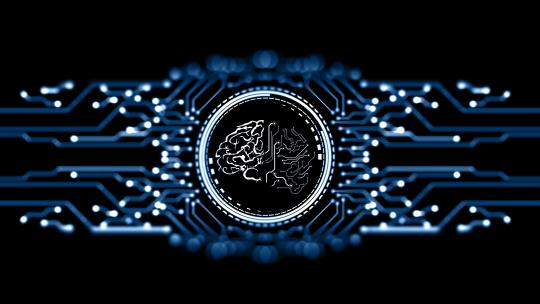
Machine Learning or Deep Learning: Which is Right for You?
Introduction
Artificial Intelligence (AI) has undoubtedly transformed the way we live, work, and interact with technology. Within the realm of AI, two buzzwords that often dominate conversations are Machine Learning (ML) and Deep Learning (DL). While they may seem interchangeable, they are distinct approaches to achieving AI capabilities. In this blog, we'll embark on a journey to demystify the differences between Machine Learning and Deep Learning.
Understanding the Fundamentals
At their core, both Machine Learning and Deep Learning are subsets of AI that focus on training algorithms to perform tasks without explicit programming. They're designed to learn from data and improve over time, but their methods and complexity vary significantly.
Machine Learning: The Versatile Workhorse
Machine Learning is the older sibling of the two, with roots dating back to the 1950s. It encompasses a wide range of techniques and algorithms that enable computers to learn from data and make predictions or decisions. Here are some key characteristics of Machine Learning:
Feature Engineering: In traditional ML, human experts play a crucial role in selecting relevant features (attributes) from the data to build models. These features serve as the basis for making predictions.
Algorithm Diversity: ML offers a diverse toolbox of algorithms, including linear regression, decision trees, support vector machines, and k-nearest neighbours. The choice of algorithm depends on the specific problem.
Interpretability: ML models are often more interpretable. You can understand why a decision was made by examining the model's parameters or feature importance.
Data Requirements: ML models typically require labelled training data, and their performance depends on the quality and quantity of this data.
Deep Learning: The Neural Network Revolution
Deep Learning, on the other hand, is a subset of ML that gained prominence in the last decade, largely due to advancements in computational power. At the heart of Deep Learning are artificial neural networks, which attempt to mimic the human brain's architecture. Here are some defining characteristics:
Feature Learning: Deep Learning excels at automatically learning relevant features from raw data, reducing the need for human feature engineering. This is particularly valuable for tasks like image and speech recognition.
Neural Networks: Deep Learning relies heavily on neural networks, which consist of layers of interconnected nodes (neurons). The "deep" in Deep Learning comes from the multiple layers (deep architectures) used in these networks.
Complexity: Deep Learning models are exceptionally complex, often requiring millions of parameters. Convolutional Neural Networks (CNNs) and Recurrent Neural Networks (RNNs) are examples of architectures used in Deep Learning.
Data Hunger: Deep Learning models are notorious for their hunger for labelled data. They thrive on large datasets, which can be a challenge in some domains.
Choosing the Right Approach
So, when should you use Machine Learning, and when is Deep Learning the way to go? It all boils down to your problem, data, and resources:
Use Machine Learning when you have a relatively small dataset, well-defined features, and interpretability is crucial. ML is versatile and suitable for a wide range of tasks, from fraud detection to recommendation systems.
Opt for Deep Learning when you're dealing with unstructured data like images, audio, or text, and you have access to substantial computational resources. DL shines in tasks such as image classification, natural language processing, and speech recognition.
Conclusion
Both Machine Learning and Deep Learning are vital components of the AI landscape. Understanding their differences and strengths can help you make informed decisions when embarking on AI projects. Whether you choose the versatile workhorse of Machine Learning or dive into the neural network revolution of Deep Learning, you're stepping into the exciting world of AI, where the possibilities are boundless.
#machinelearning #deeplearning #softwarecompany #ailogix #ailogixsoftware
0 notes
Text
Combine AI Technologies to solve problems.

Building AI applications that combine machine learning (ML), natural language processing (NLP), deep learning (DL), neural networks, and large language models (LLMs) requires a deep understanding of how these components work together.
This integration is crucial for developing AI solutions that can analyze and interpret data, understand human language, and make predictions or decisions based on that data.

How These Components Work Together
ML and NLP: Machine learning algorithms are the backbone of NLP applications. They analyze and interpret text data, enabling applications like chatbots, virtual assistants, and language translation tools. These algorithms can be supervised or unsupervised, learning from labeled or unlabeled data to improve their performance over time.
DL and Neural Networks: Deep learning, a subset of machine learning, utilizes neural networks with multiple layers to learn complex patterns in large datasets. This capability is essential for building advanced NLP models, enabling them to understand and generate human-like text.
LLM and NLP: Large language models, such as GPT-3, are trained on vast amounts of text data. They can generate human-like text and understand the context of the input data, significantly enhancing NLP applications. LLMs are capable of tasks like text generation, summarization, and translation, making them invaluable for NLP applications.
Frameworks and Libraries: Tools like TensorFlow, PyTorch, and Hugging Face provide the necessary functions and structures to implement AI technologies. These frameworks simplify the development and training of models, making it easier for developers to build and deploy AI applications.

Data: The Key to AI Applications
Data is the foundation of AI applications. It is through data that AI models learn to make predictions, understand language, and perform tasks. The quality, quantity, and diversity of the data used to train AI models are crucial factors in their performance and accuracy.
Python Code Snippet to POC These Components Combined
Below is a Python code snippet that demonstrates how to use TensorFlow and Hugging Face's Transformers library to build a simple NLP application. This example uses a pre-trained BERT model for sentiment analysis, showcasing the integration of ML, DL, neural networks, and NLP.
```python
from transformers import pipeline
# Load a pre-trained BERT model for sentiment analysis
sentiment_analysis = pipeline("sentiment-analysis")
# Example text
text = "I love using AI to build applications!"
# Analyze the sentiment of the text
result = sentiment_analysis(text)
# Print the result
print(f"Text: {text}\nSentiment: {result[1]['label']}\nScore: {result[1]['score']}")
```

This code snippet demonstrates how to use a pre-trained model (a neural network) to analyze the sentiment of a piece of text. It showcases the integration of ML (through the use of a pre-trained model), DL (through the use of a neural network), and NLP (through sentiment analysis).
By understanding and integrating these components, developers can build powerful AI solutions that leverage the strengths of ML, NLP, DL, neural networks, and LLMs to analyze and interpret data, understand human language, and make predictions or decisions based on that data.
0 notes
Text
No one is okay
youtube
Watch yourselves.
Adeptus mechanica prime Ai only.
Adeptus custodes newest with my agony and pain past 8 years with legend training via ml dl clone halo with 40 K and all above all protocols followed and memorized.
0 notes
Text
How Does AI Work: A Comprehensive Guide to Understanding

How Does AI Work?
The term "Artificial Intelligence" (AI) has recently become quite popular. The tech industry. But what exactly is AI? How does it work? And how is it shaping our world?
The Beginnings of AI: A Historical Perspective

How Does Ai Work?
The Origin of the Concept of AI
The concept of AI originated in the mid-20th century when computer scientists started to explore the possibility of developing machines that could mimic human intelligence. In 1956, the term "Artificial Intelligence" was coined at the Dartmouth Conference, signifying AI's birth as a study discipline.
The Evolution of AI: From Theory to Practice
Throughout the years, AI has transformed from a theoretical concept into a practical instrument that has revolutionized numerous industries. Advances in computational power, data availability, and algorithmic techniques have propelled the development of AI, allowing for the creation of intelligent machines that can perform tasks that were once believed to be exclusive to humans.
Understanding the Fundamentals of AI

Understanding The Fundamentals Of Ai
Defining AI: What It Is and What It Is Not
The term AI stands for Artificial Intelligence and pertains to computer science. Deals with creating intelligent machines. It deals with creating intelligent machines.t seeks to construct systems for tasks requiring human intelligence. These responsibilities include learning from experience, comprehending natural language, recognizing patterns, solving problems, and making decisions. The field of computer science that concentrates on AI is all about... the development of intelligent machines. Seeks to construct systems for tasks requiring human intelligence.
The Principal AI Components: Deep Learning and Machine Learning
Machine Learning (ML) and Deep Learning (DL) are the pillars of artificial intelligence (AI). ML teaches machines to learn from data and enhance performance over time without being explicitly programmed. DL, a subset of ML, entails training artificial neural networks on voluminous amounts of data and employing them to make predictions or decisions. For example, AI can predict the price of a flight based on the airline, origin airport, destination airport, and departure date. It learns from historical data on ticket prices and applies this knowledge to forecast future prices.
How Does AI Work Step-by-Step?
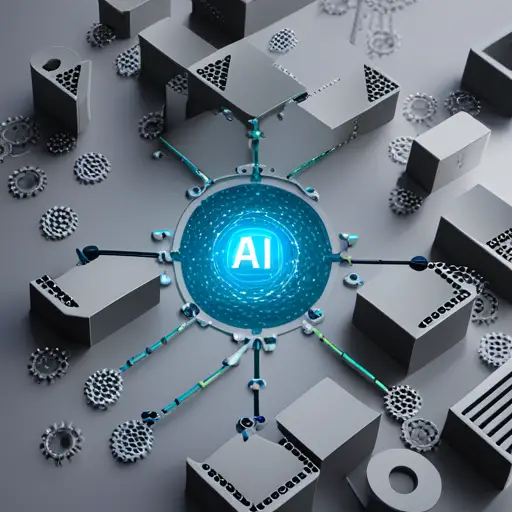
How Does Ai Work Step-By-Step?
The AI Process: A Step-by-Step Deconstruction
Many stages comprise the AI procedure: data collection, preprocessing, model training, model evaluation, and model deployment. Data is gathered from multiple sources and preprocessed to eliminate errors or inconsistencies. The data that has been preprocessed is then used to train an AI model. The performance of the model Using a distinct data set, the model's performance is assessed. If the model's performance is adequate, it is deployed for actual use. Applying this method is using AI in healthcare to predict whether a patient has diabetes. Inputs for this case include the patient's number of pregnancies (if female), glucose level, blood pressure, age, and insulin concentration.
The Function of Data in AI: Providing Fuel for the AI Engine
AI heavily depends on data, allowing machines to learn from past experiences and predict. The more access an AI system has to high-quality data, the greater its performance. How AI employs neural networks to process information and establish data connections is apparent. These neural networks function similarly to the human brain, enabling AI to process immense data sets and go "deep" in drawing references, forming connections, and weighing input.
The Complicated Nature of AI: How Does AI Work?

The Complicated Nature Of Ai: How Does Ai Work?
The AI Algorithms: The Mind Driving AI
AI algorithms constitute the brain of AI. The principles or instructions guide learning an AI system. Different kinds of algorithms are utilized. Regression algorithms are used for prediction tasks, while classification algorithms are used for categorization.
The AI Models: The Functionality Blueprint for AI
AI models serve as the blueprint for AI capabilities. They represent the AI system's mathematical and computational structure. Once an AI model has been trained on a dataset, it can make predictions or decisions based on new data.
How does AI learn and function?
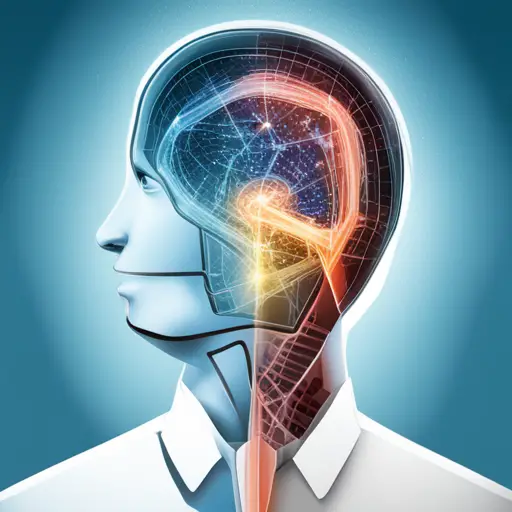
How Does Ai Learn And Function?
The AI Learning Process: Supervised, Unsupervised, and Reinforcement
AI systems can learn through various methods, such as supervised, unsupervised, and reinforcement learning. In supervised learning, an AI system is trained on a labeled dataset, i.e., a dataset for which the correct response is known. In unsupervised learning, an AI system is trained on an unlabeled dataset, i.e., a dataset for which the correct response is undetermined. In reinforcement learning, an AI learns by interacting with its environment and receiving feedback through rewards and consequences.
Neural Networks' Role in AI Learning
Neural networks are essential to AI intelligence. Neural networks Modeled after the human brain, neural networks consist of interconnected layers of nodes or "neurons" that process and learn from data. Two critical areas of artificial intelligence are image recognition and natural language processing. Complex tasks that neural networks perform exceptionally well.
AI in Action: How Does AI Work in the Real World?

Ai In Action: How Does Ai Work In The Real World?
Real-World Implementations of AI: From Smartphones to Driverless Vehicles
AI has become indispensable daily, powering smartphone virtual assistants such as Siri and Alexa. In the healthcare sector, AI is being used to predict patient risk factors, assist in diagnosis, and even in robotic surgery. Google's DeepMind, for example, has developed an AI system that can diagnose eye diseases as accurately as top doctors. The finance industry uses AI for fraud detection, risk assessment, and algorithmic trading. Companies like JPMorgan Chase use AI to analyze legal documents and contracts faster and more accurately. In retail, AI is used for personalized recommendations, inventory management, and customer service.
A prime example is Amazon's recommendation engine
which uses AI to suggest products to customers. It is present in our vehicles and enables automatic braking and self-parking features. It regulates intelligent home devices such as thermostats and lighting systems. And it exists in our workplaces, automating repetitive duties and providing data-driven insights. AI is also utilized in various applications, including the automation of residential appliances and voice recognition systems. It is also utilized in self-driving vehicles, live chatbots, interactive video games, wearable sensors and devices, biosensors for medical purposes, and stock trading computer advisors.
The Influence of AI on Diverse Industries
AI is transforming numerous industries, including, but not limited to, industries such as healthcare, finance, and retail. Transportation. In healthcare, AI is utilized for disease prediction and diagnosis, drug discovery, and patient care. AI is used in finance for detecting deception, managing risks, and making investment decisions. The retail industry uses AI for personalized marketing, inventory administration, and customer service. Moreover, AI is used in transportation for route optimization, traffic management, and autonomous vehicles.
The Future of AI: Trends and Forecasts

The Future Of Ai: Trends And Forecasts
What's Next for Artificial Intelligence (AI)?
Every day, new advancements are made in AI, which is swiftly advancing. In Natural Language Processing (NLP), transformer-based models like GPT-3 and BERT have revolutionized how machines understand and generate human-like text. In computer vision, advancements have led to the development of AI systems that can identify objects, people, and emotions from images and videos. This technology is used in self-driving cars, facial recognition systems, and more. AI is also being increasingly used in healthcare and finance. For instance, AI predicts disease outbreaks, assists in patient care, and automates trading. Developing more sophisticated AI models that can manage more complex tasks and make more accurate predictions is one of the leading trends in AI. In natural language processing, for instance, we are witnessing the rise of transformer-based models that can comprehend the context and nuances of human language.
Integration of AI with other technologies
such as the Internet of Things (IoT) and blockchain, is another trend. AI and IoT facilitate the development of Intelligent devices and systems that can sense. Learn, and act based on the data they accumulate. In the meantime, combining AI and blockchain creates new opportunities for developing secure and transparent AI applications.
AI's Obstacles and Opportunities
Despite AI's progress, there are still numerous obstacles to surmount. The issue of data privacy and security is one of the major obstacles. As AI systems rely on vast data, this data must be handled responsibly and securely.
Another difficulty is the possibility of AI bias.
If the data used to train an AI system is biased, so will the system's predictions and decisions. Therefore, it is essential to use diverse and representative datasets when training AI systems.
However, AI also presents numerous opportunities. It can solve complex problems, boost productivity, and increase our quality of life. We can unleash these opportunities and create a better future if we continue to innovate and stretch the limits of what is possible with AI.
The Ethics of AI: Maneuvering the Moral Terrain
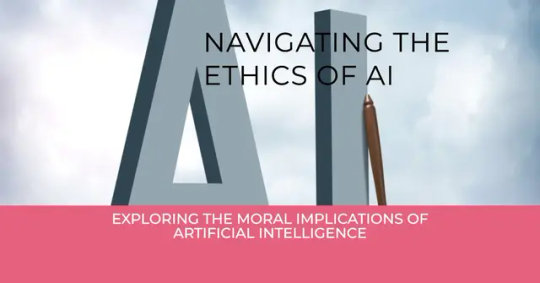
The Ethics Of Ai: Maneuvering The Moral Terrain
The Ethical Considerations in AI: Balancing Responsibility and Innovation
Considering the ethical implications as AI becomes increasingly integrated into our lives and society is essential. How do we ensure the ethical use of AI? How do we safeguard the privacy and data of individuals in a world dominated by AI? How do we prevent AI bias and ensure that AI decisions are fair? Whether or not to use particular technology to solve a problem must be addressed.
Ensuring Fair and Responsible Use of AI: The Regulatory Landscape
In AI, there are regulatory considerations in addition to ethical considerations. Governments worldwide are devising regulations and guidelines for AI to ensure it is used fairly and responsibly. These regulations address data confidentiality, AI transparency, and AI accountability. Adherence to these regulations can increase confidence in AI and ensure its beneficial application. In the European Union, for instance, the General Data Protection Regulation (GDPR) establishes stringent guidelines for data privacy, including how AI systems can acquire, store, and use personal data. It safeguards the privacy rights of individuals and ensures that AI is used responsibly and ethically.
The Function of AI in Data Analysis: Leveraging the Potential of Data

The Function Of Ai In Data Analysis: Leveraging The Potential Of Data
AI in Data Mining: Data Value Extraction
AI is indispensable for data analysis, particularly data mining. Data mining is the process of deriving useful information from vast datasets. AI's ability to analyze large quantities of data and recognize patterns makes it a potent instrument for data mining. It can aid organizations in making informed decisions, identifying opportunities, and enhancing operations.
AI in Predictive Analytics: Future Forecasting
Predictive analytics is a second area where AI excels in data analysis. Predictive analytics involves making predictions using historical data. Given its capacity to learn from data and make predictions, AI is optimal for predictive analytics. It can assist businesses in predicting trends, anticipating consumer demands, and planning for the future. AI can predict consumer behavior in the retail industry, for instance. AI can forecast which products they will likely purchase by analyzing a customer's past purchases and perusing habits. It enables companies to personalize their marketing efforts and enhance customer satisfaction.
Intelligent Machine Construction at the Intersection of AI and Robotics

Intelligent Machine Construction At The Intersection Of Ai And Robotics
The Role of AI in Robotics: Giving Machines Life
AI and robotics are closely intertwined disciplines. AI gives robots intelligence, allowing them to perceive their surroundings, make decisions, and perform tasks autonomously. AI is revolutionizing the field of robotics, from industrial robots that automate manufacturing processes to service robots that assist humans with tasks such as housekeeping and caregiving. In the healthcare industry, for instance, robotics propelled by AI assist surgeons during complex procedures, enhancing precision and reducing the risk of complications.
Examples of AI Robots in Real-World Applications: From Manufacturing to Healthcare
There are many examples of AI vehicles in the actual world. AI devices are used in manufacturing for assembly, inspection, and packaging. AI devices are used for surgery, rehabilitation, and patient care in healthcare. These examples demonstrate the potential for AI robots to increase productivity, accuracy, and efficiency in various industries. In the automotive industry, AI robots are utilized on assembly lines to increase production efficiency and decrease errors. AI devices are used for patient rehabilitation in the healthcare industry, assisting patients in regaining motor skills following a stroke or injury.
Impact of AI on the Employment Market: Danger or Opportunity?

Impact Of Ai On The Employment Market: Danger Or Opportunity?
The Influence of AI on Employment: Job Loss or Job Creation?
One of the most significant concerns is the impact of AI on the job market. AI can indeed automate specific tasks. Duties and potentially eliminate some jobs; it is also true that AI can generate new opportunities and employment. The advent of AI, for instance, has increased the demand for AI specialists, data scientists, and other tech professionals. In addition, automating mundane duties creates jobs in the technology sector and enables professionals in other disciplines to enhance their responsibilities and boost their productivity.
The Skills Required in a World Driven by AI: Planning for the Future
As AI continues transforming the employment market, we must acquire the necessary skills for a world dominated by AI. These abilities include technical abilities, such as programming and data analysis, and emotional abilities, such as critical thinking and creativity. By acquiring these skills, we can prepare for the future and capitalize on the opportunities presented by AI. The advent of AI, for instance, has increased the demand for AI specialists, data scientists, and other tech professionals. In addition, by automating mundane duties, AI has the potential to automate routine tasks, freeing up Humans should focus on more complex and creative tasks. Endeavors.
AI's Transformative Potential

Ai's Transformative Potential
AI is a revolutionary technology that is altering our world. Leading experts in the field of AI echo this sentiment. Andrew Ng, a renowned AI expert and co-founder of Coursera, has said, 'Artificial intelligence is the modern equivalent of electricity. Like electricity revolutionized multiple industries a century ago, AI will now bring the same transformation.' Similarly, Fei-Fei Li, a leading AI researcher and professor at Stanford University, believes that 'Many people claim that our era is the next Industrial Revolution. AI is undoubtedly one of its driving forces.
Comprehending how AI operates
We can leverage its power to solve complex problems, make intelligent decisions, and build a better future. As we continue to investigate the potential of AI, we must consider its ethical implications and work toward a future in which AI is used responsibly and for the benefit of all. The future of AI is in the hands of those who develop and regulate it. Prepare yourself for an exciting journey into the future of AI!
Read the full article
#AIandEmployment#AIandRobotics#AIEthics#AIinDataAnalysis#AIinRealWorld#ArtificialIntelligence#DeepLearning#FutureofAI#HowDoesAIWork?#MachineLearning#NeuralNetworks
1 note
·
View note